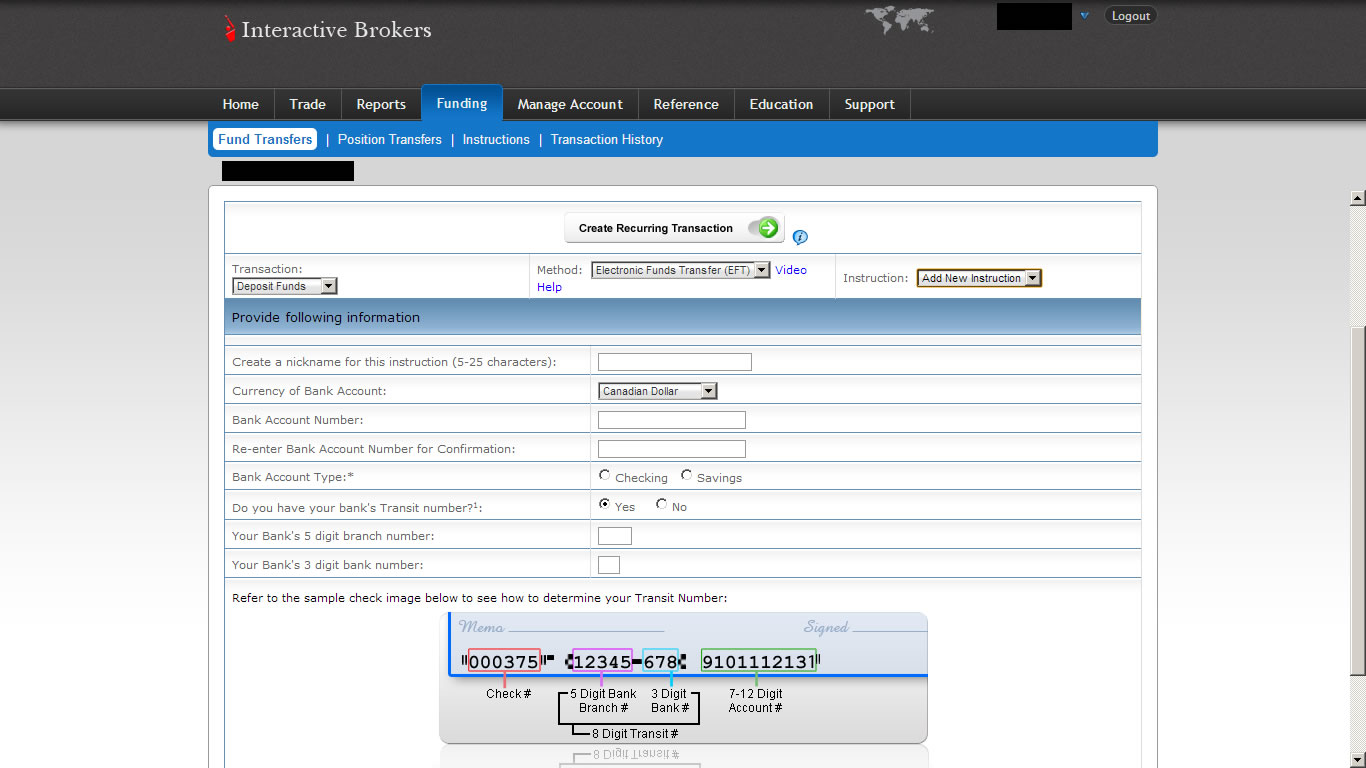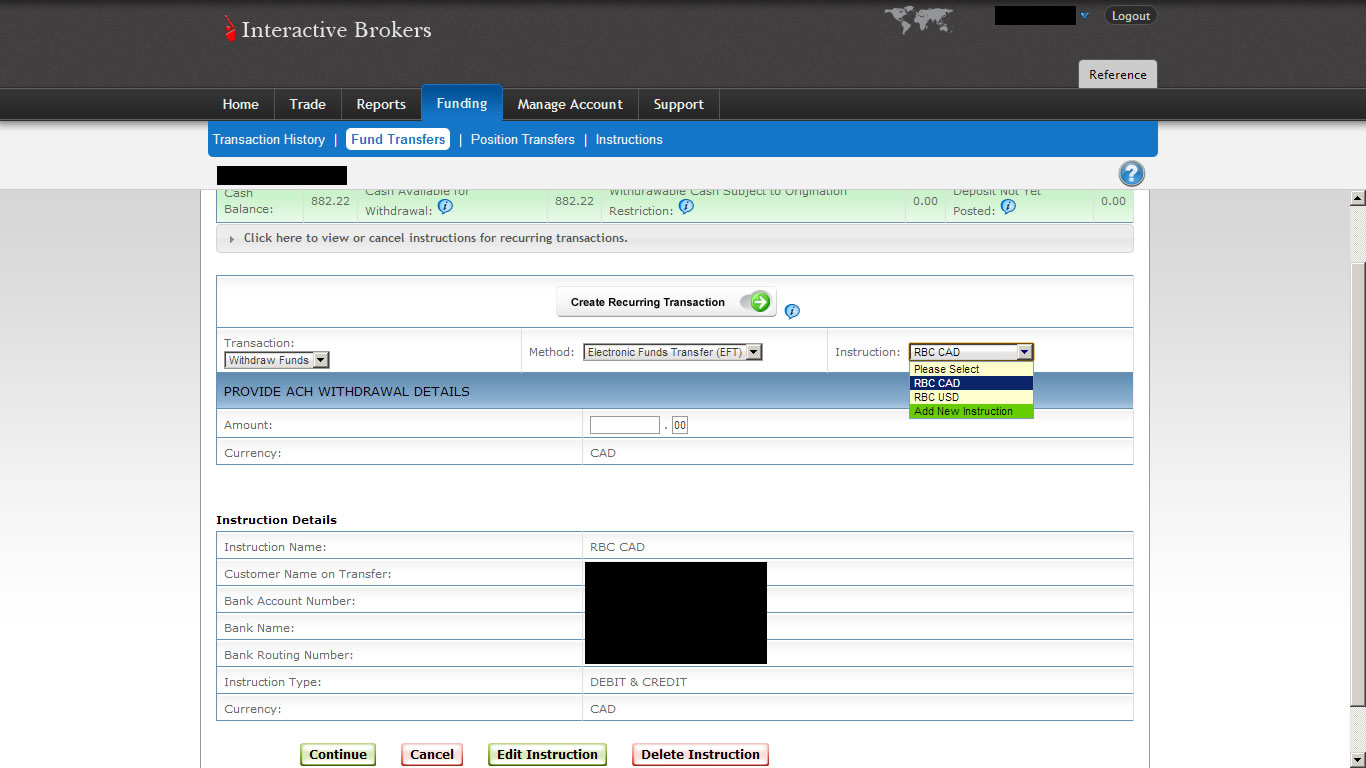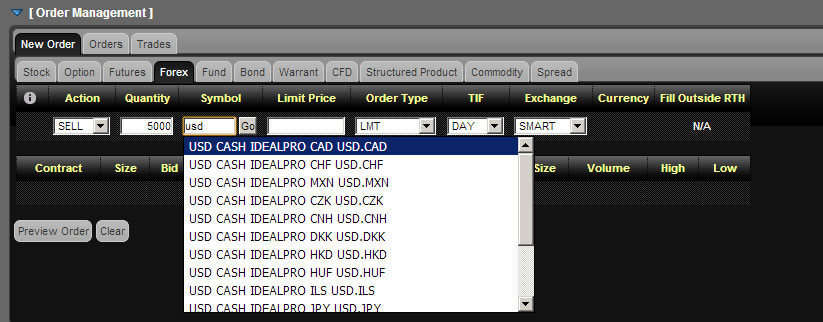Converting currencies with Interactive Brokers can be confusing at first, so, as a follow-up to my post on paying as little commission as possible when converting US and Canadian dollars, here’s a quick tutorial on how to do that.
1) Linking Accounts
If you’d like to fund your account via ETF, you’ll need to configure your bank accounts in your Interactive Brokers (IB) account. For that, you need to add what they call an “Instruction”. They’ll then make a small deposit in your bank account, you’ll confirm the amount and you’ll then be able to use the instruction to transfer funds in and out of your IB account, subject to their hold policy.
Canadians can link both CAD and USD-denominated bank accounts held at Canadian banks to their IB account.
You can add Fund Transfer Instructions in the Account Management area of the IB website:
Once you’ve validated the instruction by entering the small deposit amount that you’ve received from IB to verify your bank account, you can deposit/withdraw funds by creating a Fund Transfer Instruction, also in your Account Management area:
More information: Funding your account | Withdrawals
2) Converting Currencies
2.1) Log in to the Web Trader platform
2.2) In the order management section, choose Forex, and select Buy if you want to buy USD, and sell if you want to sell USD. Enter the amount of USD you want to sell for a SELL order, or the amount of CAD you want to convert to USD for a BUY order.
2.3) In the symbol field, type “USD” and then click the “Go” button. You should be able to choose the USD.CAD currency pair in the drop-down:
2.4) Change the order terms (order type, limit price, etc.) if you’d like.
2.5) Click “Preview Order” and make sure the information is accurate and that you’ve entered the correct amount in the source/destination currency (so you don’t end up selling the equivalent of 5000 CAD instead of 5000 USD, for example):
2.6) Click “Submit Order” and wait for your order to be filled (almost instantaneous for market orders during market hours, while limit orders may or may not be executed depending on your limit price).
That’s it! The interface may look scary at first, but I find it’s well worth the savings if you’re converting tens of thousands of dollars per year through Interactive Brokers.
3) What to do afterwards?
Depending on how you funded your account, there may be a rather long hold period for your funds (currently 3 business days for wire transfers and 60 business days for EFTs). You may leave the funds in your cash balance while waiting for the hold to expire, or you can use them to buy stocks/ETFs if you prefer. I tend to buy short-term bond ETFs like XSB and sell them after the hold period ends, but that’s a matter of personal preference.
***
I hope this information was helpful. Don’t hesitate to post in the comments if you appreciated it (it’s always nice to see that people liked a blog post) or if you have any question.




When you say “Enter the amount of USD you want to sell for a SELL order,”
are you talking about shorting the USD ? or when you place that order are you just selling USD for some other currency. I am currently opening an account with IB and want to convert 6000CAD to USD. But just confused by what you mean when you say SELL your currency, when thats said i instantly think short.
My instructions (and screenshots) are to convert USD to CAD, since that’s my use case… and it involves SELLing in Interactive Broker’s interface. If you wanted to convert CAD to USD, I’d assume you’d do the same thing, but with a BUY transaction instead. When you click “Preview order”, you’ll see the amount it gives you, and should then be able to confirm whether you entered the right order (sell or buy) and amount.
I’m not super familiar with the shorting terminology, but my understanding is that you’re not shorting a currency if you currently have it… basically, I have both USD and CAD balances in my account, and I’m selling some of the USD in my USD balance to buy CAD (that then goes in my CAD balance).
Hope this helps!
btw great blog post much appreciated !
It’s a useful article that can help many people savings a lot in commission for currency transfers.
However your explanation in detail is not correct.
You use the USD.CAD instrument in order to convert your USD to CAD. Taylor wants to convert CAD to USD.
In the USD to CAD scenario, you go short on USD.CAD because you are selling your USD. In the CAD to USD scenario, you go long on USD.CAD because you are buying USD.
This is trading terminology, IB allows you to do Forex trading, it’s not primarily a money transfer platform.
The amount you put is always USD, because you buy or sell USD.
When you want to do the conversion, you create a trade (in QuickTrade or Web trader), you choose the symbol, the type of trade (Buy or Sell) and the order type (Market, Limit, Stop etc).
If you sell USD for getting CAD, it is simple you just put the amount of USD to convert (sell). If you choose Market as order type, the order is executed asap (slippage probably not considered!). If you want to try a better exchange rate, you choose Limit and you put a rate which is higher than the current one.
If you buy USD and especially if you want to minimise the remaining CAD balance to circa 0, it is not so quick. You need to try with the correct amount until the system is happy, depending on the current market rate or the rate you have chosen. There will be an error message if your order cannot be executed. This is because the amount of USD you will achieve depends on the rate and commission. Also, the IB system is buggy, it will adapt the quantities automatically if an error is detected, but not always…
As an example, I have 1000 GBP and want it in EUR to take advantage of the current EUR to GBP rate.
In that situation, I wire-in 1000 GBP from my UK bank account to the UK account of IB. It results in a balance of 100K GBP in IB. I place a Buy trade by choosing EUR.GBP and then I need to have a look at the current rate. If I want to try a better rate, I choose a Limit Sell with the price I want to achieve. I try with the maximum amount of EUR until the system is happy (for example 1400, 1399, 1398 etc). For example the system is happy if the trade is for 1397 EUR and the GBP amount is 998.50 (it reflects the commission already). If the order is executed, then I can go to the transfer section in IB, here I will have a balance of EUR and a “residual” balance of GBP (for example 0.50 GBP). I will then wire-out 1397 EUR to a EUR bank account.
As the article says anyway, always use the preview function before placing the trade.
Thanks for your detailed explanation – that’s helpful!
I followed the instructions to convert CAD to USD and think I was successful. In my portfolio I now see an open “position” “USD, Cash, IDEALPRO, CAD” with the amount I converted… not sure what this is?
You can see Darragh Egan’s comment with an explanation. Sorry for the delay!
One clarifying question. After the sub-steps of “2) Converting Currencies” are completed, I would be left with an “open position” in the Idealpro contract (along with CAD).
What happens next? If I were to wire that CAD out, does IB simply close out the open position automatically?
Thanks for the article.
You can see Darragh Egan’s comment with an explanation. Sorry for the delay!
I have used the same approach to convert USD to CAD with Interactive Brokers, and I wanted to point out something that I found confusing and might confuse others as well. After performing this transaction (selling the USD.CAD currency pair), it will continue to show in your account as an open position. This position will show an Unrealized P&L which will fluctuate with the exchange rate. Closing the position would essentially reverse your transaction (convert CAD back to USD) at the prevailing rate which is not something I would want to do. I am only trying to convert my money from USD to CAD, not to actively trade forex positions.
I spoke to Interactive Brokers and they explained that this is merely a “Virtual Position” and not an actual position and I can simply ignore it and look at my settled Cash balance to see what currency I actually have in the account. They also said they can remove virtual positions from the portfolio view in Trader Workstation but not in Web Trader.
That’s great info – thanks!
I’m trying to add my Canadian bank account to my Interactive Brokers account. However, it seems the “Fund transfers” page has changed; it now asks for the currency first before letting you specify the transfer method. When you select “CAD” as currency, the only option available is “Wire”. There is no “EFT” option. Am I missing something? I really don’t want to pay wire transfer fees to transfer my CAD over to Interactive Brokers.
Sorry for the delay – choosing CAD shows me EFT as an option, but I have a Canadian IB account. Is yours with Interactive Brokers CA or US?
Yeah, that was the difference. My IB account was with Interactive Brokers US.
I ended up asking my Canadian bank to perform a wire transfer to IB, which was expensive, but the rest of the process was the same.
Thank you so much. Been looking for such a post for 2 months. I have IB account in USD and I have a savings USD account at RBC. Now I know how to convert thru IB. Thanks again 🙂
Glad I could help!
Thanks for this post. Very useful.
Thanks for the instructions. Their Web UI is sooo complex!
You may remove a virtual forex position from display within the TWS Account Window.
To open the Account Window, click on the Account menu at the top of the TWS and select Account Window.
Then, refer to the “FX Portfolio – Virtual FX Position” section and locate the virtual position displayed there.
Right-click on the virtual position and select “Adjust Position or Average Price.”
When the small window appears, type the number zero into each field and click OK. The position will then disappear.
(No orders need to be placed to accomplish this.)
That’s good to know – thank you!
I know this is an old subject, but IB is now kicking people out who are using their platform mostly for currency exchanges. If you know an alternative I’m looking for one now.
That’s good to know – I was not aware of that. Depending on your needs, TransferWise might be a good option?